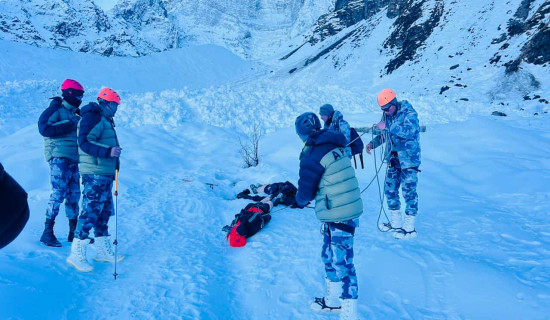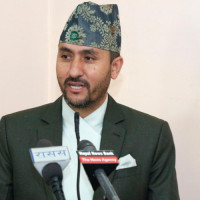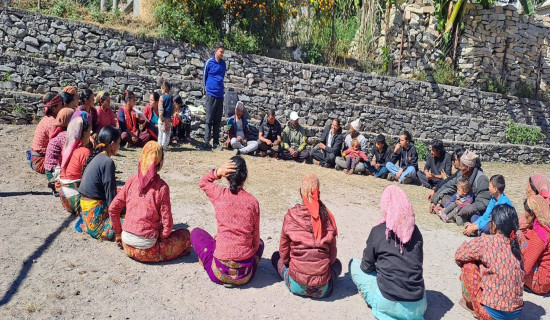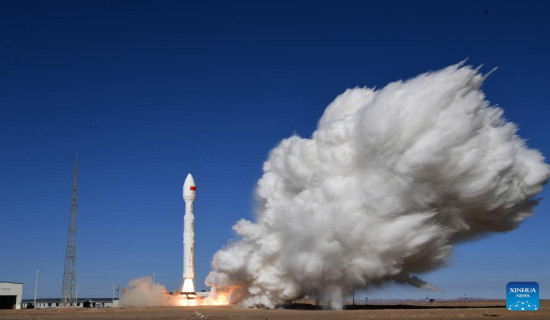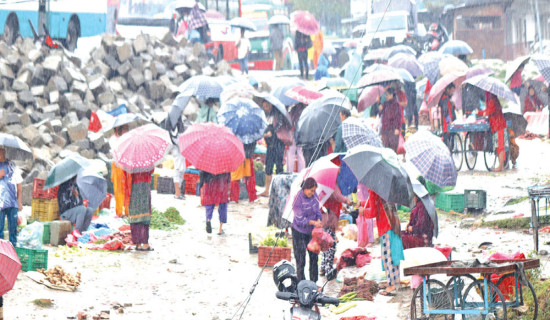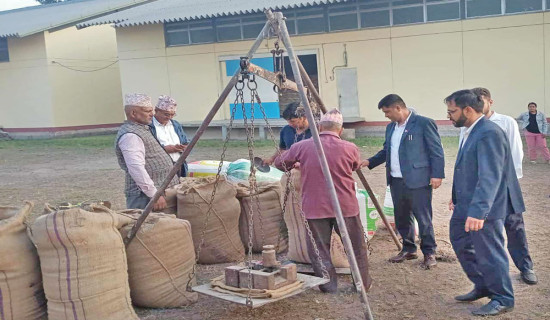- Sunday, 9 November 2025
A Decade On, Economic Dreams Remain Unfulfilled
Nepal implemented a new constitution on September 20, 2015. With the promulgation of the new constitution, many had expected the country to embark on the path of economic prosperity. This national charter has a clear objective of building an economically self-reliant, independent and progressive economy.
The directive principles of the constitution state the goal of achieving sustainable economic development through the participation of the public, private and cooperative sectors, ending economic inequality and building an exploitation-free society, and developing a socialist-oriented economy. It emphasises maximising the mobilisation of available means and resources for national development.
High hopes but slow progress
In the decade since the promulgation of the constitution, the expected level of economic progress has not been achieved. Experts point to several persistent issues – low productivity, lack of industrial development, and minimal job creation. Consequently, hundreds of thousands of youth have been forced to seek employment abroad, raising concerns about the poor implementation of economic policies.
Although the constitution considers the cooperative sector as one of the key pillars of national development, recent years have seen widespread financial irregularities and a lack of transparency within cooperative organisations. This has significantly eroded public trust in the cooperative system.
The global COVID-19 pandemic severely disrupted Nepal's economic activities. In addition to economic contraction, people's incomes declined, reducing overall purchasing power. The subsequent monetary tightening by the Nepal Rastra Bank (NRB) and the government's inconsistent economic policies further slowed down private sector investment, particularly due to rising interest rates.
Frequent changes in government over the past decade have also hindered the effective implementation of economic development programmes. Major political parties have led the government repeatedly since the promulgation of the constitution. They consistently prioritised production and productivity and building a self-reliant economy. However, production and productivity have not increased as expected, and they have not been able to create enough jobs.
Similarly, major infrastructure projects have suffered from inadequate budget allocation and poor execution, with the government failing to spend even 70 per cent of the annual development budget.
The unstable economic policies adopted with the changes of the government and after the impact of the COVID-19 pandemic have affected the private investment.
Domestic economy has been sluggish due to the restrictive policies adopted by the NRB and the government after foreign exchange reserves fell to cover less than 5.5 months of imports of goods and services in 2021/22, opined industrialists.
Similarly, the government also adopted various policies to discourage imports, real estate investment, and the stock market. When these sectors were affected, economic activities shrank, which affected overall demand. Restrictive policies not only weakened the confidence of the private sector but also curtailed their investment.
Interest rates rose to as high as 16 per cent, forcing private sector investment, contributing 80 per cent to the economy, to shrink.
Similarly, imports were also affected, and the foreign exchange volume rose to its highest point ever of Rs. 2,677.68 billion by mid-July 2025.
The country's GDP per capita was approximately USD 714 in 2014, and it has reached USD 1,517. Nepal is now working towards a higher goal of high-middle-income status by 2043, focusing on governance, resource management, and investment reforms to improve its economic prospects and prepare for graduation from the LDC category by 2026.
The constitution had raised expectations of good governance and a crackdown on corruption. However, corruption continued to rise rather than decline. Although every government since 2015 has pledged to prioritise anti-corruption efforts, implementation has consistently fallen short. All of a sudden, the Gen-Z protestors took to the streets on September 8 in Maitighar, demanding good governance and corruption control, which unfortunately turned violent. This has culminated in forming the interim government led by former Chief Justice Sushila Karki, mandating a six-month term to conduct elections to the HoR.
Economic growth, structure
The size of Nepal's economy has reached Rs. 6,107 billion in the current fiscal year 2024/25. The GDP was Rs. 2,124 billion in 2014/15. It shows that the country's economy expanded by almost three times in a decade.
The contribution of the agriculture and industry sectors to GDP is declining, while that of the services sector is rising. The agriculture sector's contribution to GDP dropped to 25 per cent in 2024/25 from 33 per cent in 2014/15. However, the population's engagement in this sector remained high at 62 per cent. The contribution of the secondary sector, including the industrial sector, to the GDP also dropped to 12 per cent from 15 per cent in the last 10 years.
This shows that the investment in industries is affected, resulting in reduced job creation and productivity. However, service is taking an upward trend, and its contribution to the GDP reached 62 per cent in 2024/25. It was limited at 51 per cent in 2014/15. The ICT sector has experienced a rapid growth, revolutionising how Nepalis interact, learn, and do business.
The growth is estimated to be at 4.61 per cent in the fiscal year 2024/25, which was around 4 per cent in 2014/15.
The country's economy which was moving on the path of recovery from COVID-19 pandemic has been affected again by the restrictive policies adopted by the NRB in 2021/22. Economic growth shrank at 2 per cent in 2022/23, 3.7 per cent in 2023/24 and 4.61 per cent in 2024/25.
The country rose from the pandemic and achieved economic growth of 4.8 per cent in 2020/21, and 5.6 per cent in 2021/22.
With low domestic investment and sluggish industrial growth, foreign employment has become a vital source of income. Remittances help maintain the balance of payments and sustain household consumption. Nepal received a record high remittance of Rs. 1,723 billion last fiscal year.
However, this dependence reflects the lack of structural transformation in the economy. Experts argue for a long-term strategy to increase domestic production, promote exports, and develop alternative revenue sources.
A significant share of the government's revenue is from customs. Due to limited income, budget allocation for infrastructure construction shrank. Nearly 80 per cent of the government's revenue collection is spent on recurrent expenses. This shows that the government has to rely on foreign and domestic loans and foreign grants for debt servicing and development. The public debt has also increased by fivefold in a decade to Rs. 2,669 billion as of mid-July 2025.
Infrastructure, hydropower development
Over the past decade, significant progress has been made in infrastructure development. Road connectivity has reached villages, and the construction of quality school buildings, health posts, and agricultural facilities like cold storage has made it easier for the public. However, the pace of infrastructure development remains slow due to the government bodies' lack of budget and weak institutional capacity.
Since the promulgation of the first constitution after the country embraced the federal system in 2008, the three tiers of government – federal, provincial, and local – have extended their work for infrastructure development.
The devastating earthquake in 2015, the COVID-19 pandemic, and other natural disasters that occurred frequently have affected the development endeavour of the country. However, the government expedited the reconstruction works across the country. Almost all heritage sites have been reconstructed so far.
Likewise, significant growth has been achieved in the hydropower sector. The installed hydropower capacity has reached around 3,600 MW, while it was 729 MW in 2015. The national grid access has reached about 98 per cent.
Surplus electricity is now being exported to India and Bangladesh, generating billions in revenue. Under the Electricity Development Roadmap, the government aims to generate 28,500 MW by 2035.
Way forward
A decade after the promulgation of the constitution, the journey towards economic transformation remains progressive and challenging. While a milestone in hydropower infrastructure, and ICT highlights potential, issues like policy inconsistency, corruption, weak industrial growth and heavy reliance on remittance continue to hinder sustainable economic progress. Ensuring stable leadership, long-term economic vision, prioritising investment and structural transformation will be crucial in realising the constitution's promises for a prosperous Nepal.
(Kafle is a journalist at The Rising Nepal.)



